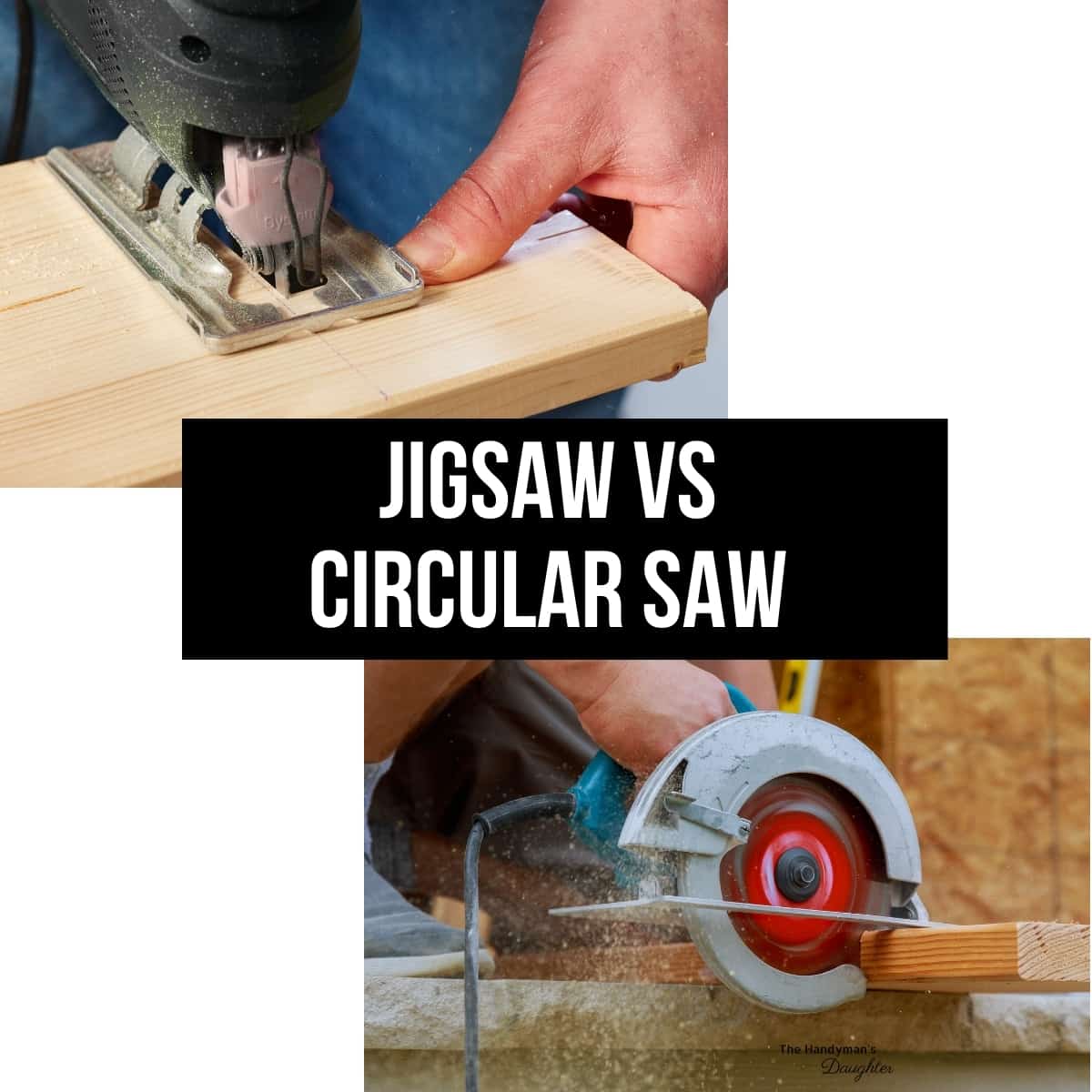If you find yourself wondering, “Can I use a jigsaw instead of a circular saw?” you’re in the right place! 🤔 Let’s explore this question and find out whether you can switch up your power tools. Whether you’re a curious DIY enthusiast or just starting your woodworking journey, understanding the capabilities, functions, and differences between these two tools is essential. So, let’s dive in and explore the world of jigsaws and circular saws together! 💪
Now, before we get into the nitty-gritty details, let’s talk about the basics. A jigsaw is a versatile handheld power tool that primarily excels in making curved cuts. It’s like having a precision cutter that can effortlessly maneuver through wood, metal, plastic, and even ceramic tiles with ease. On the other hand, a circular saw is a bit more powerful and designed for straight cuts. It features a circular blade that spins to slice through various materials, including wood, metal, and plastic.
So, can a jigsaw really replace a circular saw? Well, the short answer is… it depends! While both tools have their own strengths and purposes, they do have some overlapping capabilities. So, let’s explore when you can reach for your trusty jigsaw in place of a circular saw and when it’s best to stick with the classic circular saw for those straight-line cuts. 🤔
Join me as we embark on this delightful woodworking adventure, exploring the similarities, differences, and ideal use cases for jigsaws and circular saws. So grab your safety goggles and let’s find out if a jigsaw can be the perfect substitute in your woodworking toolkit! 🛠️✨
Looking to cut some wood but wondering if you can use a jigsaw instead of a circular saw? While they serve similar purposes, there are a few key differences to consider. A jigsaw is great for making curved cuts and intricate designs, while a circular saw is better for straight cuts and larger projects. Additionally, a circular saw offers more power and precision. Ultimately, the choice depends on your specific needs and the type of cuts you’ll be making.

Can I Use a Jigsaw Instead of a Circular Saw?
When it comes to woodworking and DIY projects, having the right tools can make all the difference. Two commonly used power tools for cutting wood are the jigsaw and the circular saw. But what if you find yourself in a situation where you only have one of these tools? Can you use a jigsaw instead of a circular saw, or vice versa? In this article, we will explore the capabilities of both tools, their differences, and when it is appropriate to use a jigsaw instead of a circular saw.
Differences Between a Jigsaw and a Circular Saw
Before we delve into whether a jigsaw can be used instead of a circular saw, let’s first understand the differences between these two tools. A circular saw is a handheld power tool that uses a circular blade to make straight cuts through various materials, including wood, metal, and plastic. It is typically used for making long, straight cuts and is designed to be used with a guide or a straight edge to ensure accurate cuts.
On the other hand, a jigsaw is a versatile power tool that uses a reciprocating saw blade to make curved, intricate cuts in various materials, including wood, metal, and plastic. It is commonly used for cutting shapes, curves, and angles. Unlike a circular saw, a jigsaw allows for greater freedom of movement and is capable of making cuts at different angles and depths.
Can a Jigsaw Replace a Circular Saw?
While a jigsaw and a circular saw are designed for different purposes, there may be situations where you can use a jigsaw instead of a circular saw. Here are three scenarios where a jigsaw can be a suitable alternative to a circular saw:
- Curved Cuts: If you need to make curved cuts in wood or other materials, a jigsaw is the tool of choice. Its ability to cut in any direction makes it ideal for creating intricate designs, cutting out shapes, or making rounded cuts.
- Plunge Cuts: A jigsaw can also be used for plunge cuts, where you need to start a cut in the middle of a piece of material rather than at the edge. This can be useful when creating openings for electrical outlets or making cutouts for pipes.
- Tight or Confined Spaces: In situations where a circular saw may be too large or difficult to maneuver, a jigsaw can be a better option. Its compact size and versatility allow for cutting in tight or confined spaces where a circular saw may not fit.
While a jigsaw can be used as a substitute for a circular saw in these scenarios, it’s important to note that there are limitations. A circular saw is better suited for making long, straight cuts with precision and speed, especially when using a guide or a straight edge. Additionally, a circular saw can handle thicker or tougher materials more efficiently than a jigsaw.
Benefits of Using a Jigsaw Instead of a Circular Saw
When considering whether to use a jigsaw instead of a circular saw, there are several benefits to take into account:
- Versatility: A jigsaw is a highly versatile tool that can make a wide range of cuts, including curves, angles, and plunge cuts. This versatility allows for greater creativity and flexibility in your woodworking projects.
- Precision: Due to its maneuverability and ability to make intricate cuts, a jigsaw often provides greater precision and accuracy than a circular saw, especially when cutting curves or irregular shapes.
- Safety: Using a jigsaw may be safer in certain situations, especially when working with intricate designs or making delicate cuts. The smaller blade size and slower cutting speed of a jigsaw can reduce the risk of accidents or kickback.
Despite these advantages, it is essential to evaluate the specific requirements of your project and the materials you are working with before deciding whether to use a jigsaw instead of a circular saw. In some cases, it may be necessary to use both tools to achieve the desired result.
Additional Factors to Consider
While the decision to use a jigsaw instead of a circular saw ultimately depends on the specific project and requirements, here are a few additional factors to consider:
Material Type and Thickness
The type and thickness of the material you are working with can significantly impact whether a jigsaw is a suitable substitute for a circular saw. A jigsaw is generally better for cutting thinner materials, such as plywood or particleboard, while a circular saw is more efficient at cutting thicker or denser materials, such as hardwood or metal.
Accuracy and Speed
If you require precise, straight cuts over long distances, a circular saw may be the better choice. Circular saws are designed for making quick, accurate cuts with the help of a guide or a straight edge. While a jigsaw can provide greater precision for curved cuts, it may not be as efficient for straight cuts over extended distances.
Personal Experience and Skill Level
Your personal experience and skill level with each tool should also be taken into consideration. If you are more comfortable and experienced with using a jigsaw, you may be able to achieve better results with it, even for tasks traditionally performed by a circular saw. However, if you have limited experience with a jigsaw, it may be best to stick to a circular saw for more straightforward and precise cuts.
Tips for Using a Jigsaw Instead of a Circular Saw
If you decide to use a jigsaw instead of a circular saw, here are a few tips to ensure the best results:
- Choose the Right Blade: Different jigsaw blades are designed for specific materials and types of cuts. Select a blade that is appropriate for the material you are working with to achieve clean and accurate cuts.
- Use a Guide or Template: To ensure straight cuts, use a guide or template to guide the jigsaw along the desired cutting path.
- Clamp Down the Material: Secure the material firmly in place before cutting to prevent it from moving or vibrating, which can cause inaccurate cuts or damage to the material.
- Take Your Time: Cutting with a jigsaw requires patience and precision. Take your time and go slowly to maintain control and achieve clean, accurate cuts.
- Practice on Scrap Material: If you are new to using a jigsaw, practice on scrap material before attempting cuts on your actual project. This will help you familiarize yourself with the tool and improve your technique.
Conclusion:
While a jigsaw can potentially be used instead of a circular saw in certain situations, it is important to assess the specific project requirements and the materials being worked on. While a circular saw is typically better suited for making long, straight cuts with precision and speed, a jigsaw excels at creating curved and intricate cuts. Consider the distinctions between these tools and their respective strengths to determine the best tool for the job. Lastly, always prioritize safety and accuracy when using power tools.
Key Takeaways: Can I Use a Jigsaw Instead of a Circular Saw?
- 1. You can use a jigsaw instead of a circular saw for certain tasks like cutting curves or small intricate shapes.
- 2. A jigsaw is more maneuverable and versatile but may not provide the same cutting power as a circular saw.
- 3. When using a jigsaw, choose the right blade for the material you’re cutting and take care to follow safety precautions.
- 4. Circular saws are better suited for straight cuts and heavy-duty tasks where speed and precision are crucial.
- 5. Ultimately, the choice between a jigsaw and a circular saw depends on the specific job at hand and your personal preference.
Frequently Asked Questions
Welcome to our FAQ section on using a jigsaw instead of a circular saw. If you’re wondering about the versatility of a jigsaw compared to a circular saw, you’ve come to the right place. Below, you’ll find answers to some commonly asked questions that can help you make an informed decision.
1. Can a jigsaw replace a circular saw?
Absolutely! While a jigsaw and a circular saw are different tools with different purposes, a jigsaw can certainly be used as a substitute for a circular saw in certain situations. With its ability to make intricate cuts and navigate tight curves, a jigsaw is ideal for detailed woodworking projects that require finesse.
However, it’s important to consider the limitations of a jigsaw. It may not be as efficient as a circular saw when it comes to cutting thick materials or making long, straight cuts. For such tasks, a circular saw is the better choice due to its larger blade and higher power.
2. What types of cuts can I make with a jigsaw?
A jigsaw is incredibly versatile and can make a variety of cuts, including straight cuts, curved cuts, and bevel cuts. Its adjustable shoe allows for angled cuts up to 45 degrees, making it suitable for different woodworking projects.
When it comes to straight cuts, a jigsaw may not be as precise as a circular saw, but with a guide or a straight edge, you can achieve reasonably accurate results. For curved cuts and intricate shapes, a jigsaw is unparalleled in its ability to navigate corners and cut along curves with ease.
3. What materials can I cut with a jigsaw?
A jigsaw is designed to cut through a variety of materials, including wood, plastic, metal, and even ceramic tiles. However, it’s important to use the appropriate blade for each material to ensure clean and efficient cuts.
For wood and plastic, a general-purpose blade with fine teeth will provide smooth and precise cuts. When cutting metals, it’s important to use a blade specifically designed for metal cutting, as it has a higher tooth count and is made of a more durable material. Similarly, cutting ceramic tiles requires a diamond-grit blade designed for tile cutting.
4. What are the safety considerations when using a jigsaw?
Just like any power tool, safety should always be a top priority when using a jigsaw. Here are a few important safety tips to keep in mind:
– Always wear the appropriate safety gear, including safety goggles and ear protection.
– Ensure the material you’re cutting is secure and stable to prevent kickback or movement.
– Keep your hands away from the cutting area and use clamps or guides to maintain control.
– Use the correct blade for the material you’re cutting to ensure optimal performance and safety.
5. How do I choose between a jigsaw and a circular saw?
The choice between a jigsaw and a circular saw ultimately depends on your specific needs and the type of projects you plan to undertake. If you require precise cuts, intricate shapes, or curved cuts, a jigsaw is a great choice. On the other hand, if you often work with thick materials or need to make long, straight cuts, a circular saw will be more efficient.
Consider the versatility and limitations of each tool, as well as your personal preferences and the projects you commonly work on. Having both tools in your arsenal can provide you with the best of both worlds and cover a wide range of woodworking needs.

CIRCULAR SAW VS. JIGSAW…Which One Should You Own?! (FULL COMPARISON—New DIYers Should Watch!!)
Summary
If you’re wondering whether a jigsaw can be used instead of a circular saw, the answer is yes, but with limitations. A jigsaw is great for curved cuts and smaller projects, but not ideal for long, straight cuts or heavy-duty materials.
While a jigsaw offers more versatility, a circular saw provides better precision and power. It’s important to consider your project’s requirements and choose the right tool for the job. So, if you need straight cuts or are working with large pieces of wood, a circular saw is the way to go. However, if you’re tackling intricate shapes or smaller tasks, a jigsaw may be sufficient.
